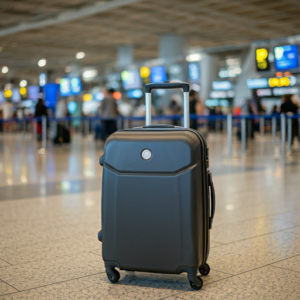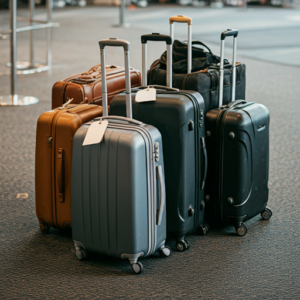Traveling by air involves a variety of processes that ensure the safe and efficient transportation of passengers, their luggage, and other cargo. While you may think of the check-in process and waiting at the gate, there’s a lot happening behind the scenes to ensure that your belongings make it to your destination safely. So, where does luggage go on a plane? It is stored in the aircraft’s cargo hold, a secure area beneath the passenger cabin, where it is carefully loaded, stored, and transported to your destination. This guide will take you through the journey of checked baggage, the crucial role of the air cargo’ hold, and the logistics involved in storing and landing luggage.
Table of Contents
Where Does Luggage Go on a Plane: The Journey of Checked Baggage
Once you arrive at the airport, your first step is checking in, where you’ll be asked to weigh your suitcase or bag. This process is essential to ensure your luggage complies with the airline’s weight restrictions, which helps avoid issues at the gate and guarantees a smooth travel experience for all passengers. Once weighed, your bag is tagged with a label that contains specific, flight information and details and an ID number, acting as a unique identifier for your luggage. After check-in, you might wonder, “where does luggage go on a plane?” Your bag will be sent to the cargo hold, where it will be stored for the duration of the flight.
The label is vital for tracking your luggage throughout the end of its journey. Even if you have a connecting flight, this label ensures that your bag is properly routed to your final destination. While the check-in staff will assist you in this process, it is essential to double-check that all information is correct to prevent any mishaps.
After your bag is tagged, it makes its way to a conveyor belt, an automated system that minimizes manual handling. This conveyor belt transports your luggage to the next stage of its journey, reducing the risk of mishandling and streamlining the process. As your bag moves through various stages of security and sorting, advanced scanning technologies ensure it meets safety standards, preventing prohibited items from being brought aboard.
Once cleared, your luggage is prepared for loading onto the aircraft in baggage compartment. Baggage handlers play a critical role in this step, carefully loading each item into the plane’s cargo hold with precision and care. Their goal is to ensure that all luggage is securely stored and balanced within the cargo space, which is vital for the aircraft’s performance and safety during the flight.

Cargo Hold
The cargo hold, located beneath the floor of the passenger cabin, serves as the primary storage area for all checked baggage and other essential cargo. If you’re wondering where does luggage go on a plane, this is the area where it is stored. The cargo hold is designed to transport a wide variety of items securely, from personal luggage to more sensitive or dangerous goods, like pharmaceuticals or perishables. It is equipped with systems that regulate the temperature and pressure, ensuring the safety of all contents during the flight.
In addition to regular luggage, the cargo hold often accommodates special items such as musical instruments, sports equipment, and even pets traveling in approved carriers. These items are given special consideration, with baggage handlers taking extra care to ensure their safe and secure air transport.
The efficiency of space utilization in the cargo hold is of utmost importance. Baggage handlers work meticulously to categorize and arrange luggage based on size and weight, optimizing the space available while ensuring the aircraft’s balance is maintained. The careful organization of items in empty cargo hold is not just for storage; it’s essential to minimize the risk of damage during flight and to contribute to the overall safety of the aircraft.
Tracking technology plays an important role in ensuring that luggage remains accounted for throughout its journey. Airlines use sophisticated systems to monitor the location of checked baggage, which helps prevent lost luggage and provides peace of mind to passengers. These systems also allow for real-time tracking, giving both airlines and travelers the ability to confirm the status of their belongings at any time.
Storage of luggage on a plane depends largely on the type of aircraft and the specific requirements for different types of cargo. If you’re wondering where does luggage go on a plane, modern airlines have developed complex systems to accommodate various categories of luggage, ranging from regular checked bags to special items such as live animals or temperature-sensitive cargo containers.
Most commercial passenger aircraft have storage compartments located in the lower part of the airplane and fuselage, known as the “belly” of the plane. These belly cargo holds are designed to maximize space and ensure the safe transport of items during the flight. Access to these compartments is through large cargo doors, and they are equipped to maintain the right environmental conditions, including pressure and temperature, to protect the contents.
Larger aircraft, such as wide-body jets, feature dedicated cargo decks in addition to the belly holds. These decks are used for transporting larger, heavier cargo, such as freight or oversized luggage. The added capacity of cargo airplanes on these aircraft makes them essential for both passenger and freight transport, allowing airlines to carry large amounts of cargo alongside passengers.
In contrast, smaller aircraft may not have specialized cargo compartments. In such cases, cargo may be loaded directly into the passenger cabin or into a designated storage area within or underneath the fuselage. While this latter unloading method is more common for short-haul flights or specific routes with limited cargo demand, it still requires strict adherence to safety regulations, ensuring that the load is balanced and secure for the flight.
What Happens to Your Baggage After Check-In: Behind the Scenes of Airport Handling
After checking in, your bag embarks on a journey through a maze of conveyor belts and security screenings, ensuring that it reaches the aircraft in perfect condition. If you’re wondering where does luggage go on a plane, security personnel utilize cutting-edge scanning technology to inspect each piece of luggage, ensuring it’s free from prohibited items that could pose a threat to flight safety.
Once cleared by security, baggage handlers take charge, ensuring that each piece passenger baggage is securely loaded into the plane’s cargo hold. These professionals take great care in arranging luggage according to size and weight, optimizing the space to maintain the aircraft’s balance. This process is critical for ensuring that the flight remains stable, even in turbulent conditions.
Checked Bag vs. Carry-On: What You Need to Know
When choosing between checking a bag or carrying one on board, there are several factors to consider. Carry-on bags are compact, easy to access, and fit into the overhead compartments of the aircraft. They are ideal for passengers who need access to personal items like a book, snacks, or medications during the flight. However, if you’re wondering where does luggage go on a plane, carry-ons are subject to strict size and weight limitations, and if overhead bins are full, you may be required to stow your bag under the seat in front of you.
On the other part of plane where luggage is stored by hand, checked luggage is stored in or inside the plane’s cargo hold and is inaccessible during the flight. While you won’t have access to your belongings until you reach your destination, checked bags allow for greater packing flexibility, especially for longer trips or when carrying larger items like clothing or souvenirs. Baggage handlers ensure that checked luggage is securely stored and transported to the correct destination.
Choosing between checked and carry-on luggage depends largely on the nature of your trip. For a quick business trip, for example, a carry-on may suffice, while a long vacation might require checking multiple bags. It’s also essential to consider your airline’s baggage policies, as different airlines have varying rules regarding checked baggage allowances and fees.

The Role of Baggage Handlers
Baggage handlers are the unsung heroes of the travel process, playing a crucial role in ensuring that your luggage arrives safely at your destination. They are responsible for the efficient transport of bags from the check-in counter to the cargo hold, using mobile conveyor belts to streamline the process and reduce physical strain. If you’re wondering where does luggage go on a plane, these systems also ensure that bags are properly placed in the cargo hold, optimizing available space and maintaining the aircraft’s balance.
Baggage handlers meticulously categorize and stack luggage, carefully considering the size and weight of each item. This kind of careful arrangement ensures that bags remain secure and are not subject to shifting during flight, which could potentially affect the plane’s stability.
Handlers also work in close coordination with the flight attendant, crew and security personnel, who are tasked with scanning each bag for prohibited items. Together, these professionals ensure that all luggage is cleared for travel and properly loaded onto the aircraft.
Tips for Travelers: Maximizing Your Rewards and Minimizing Hassle
When planning your trip, consider leveraging travel rewards programs, such as travel credit cards, to maximize your benefits. These cards can offer valuable perks like points or miles for each purchase, airport lounge access, and travel insurance. If you’re curious about where does luggage go on a plane, some cards also provide services like expedited baggage handling. Popular options include the Chase Sapphire Preferred Card and the Capital One Venture Rewards Credit Card, both offering flexible redemption options and generous rewards.
Additionally, if you’re traveling on an airline with a more lenient baggage policy, for instance, like Southwest or JetBlue, you may be able to check a bag for free. This can save you money on your trip, especially if you’re traveling with family or on a longer journey.
For connecting flights, rest assured that your checked baggage will be transferred automatically from one plane to another. Airlines handle this process with precision, ensuring that your luggage arrives at your final destination without requiring you to recheck it.
Airline Baggage Policies and Fees
Most airlines charge for checked baggage, though the fees can vary based on your ticket class, frequent flyer status, and destination. For domestic flights, the fees are generally lower compared to international flights, where they can be significantly higher. It’s important to check the baggage fees and policies of your airline before booking your flight to avoid any surprises at the gate.
Some airlines may only offer a free personal item, which is typically a small bag that fits under the seat in front of you. If you’re wondering where does luggage go on a plane, checked bags are placed in the cargo hold. If you need to check additional bags, you’ll need to factor in the associated costs. Airline loyalty programs or co-branded credit cards may offer perks such as free checked bags, further enhancing your travel experience.
Understanding these baggage policies can make your flying journey smoother and help you manage your travel costs effectively.
Conclusion – Frequently Asked Questions
Where is luggage stored on a plane?
Luggage on a plane is stored in the cargo hold, which is located beneath the passenger cabin. This area is specifically designed to securely accommodate all checked baggage and other essential cargo during the flight.
What is a place to keep the luggage called?
The place where luggage is kept on a plane is called the cargo hold or baggage compartment. It is a secure space that ensures the safe transport of passengers’ belongings from one destination to another.
Where to keep luggage in a plane?
On a plane, checked luggage is stored in the cargo hold, while carry-on luggage is kept in the overhead compartments or under the seat in front of you within the passenger cabin. This setup allows passengers to access essential items during the flight while larger items are safely stored below.
What is a luggage compartment called?
A luggage compartment on a plane is commonly referred to as the cargo hold or baggage compartment. This area is designed to store checked bags and other items that need to be transported safely during the flight.










